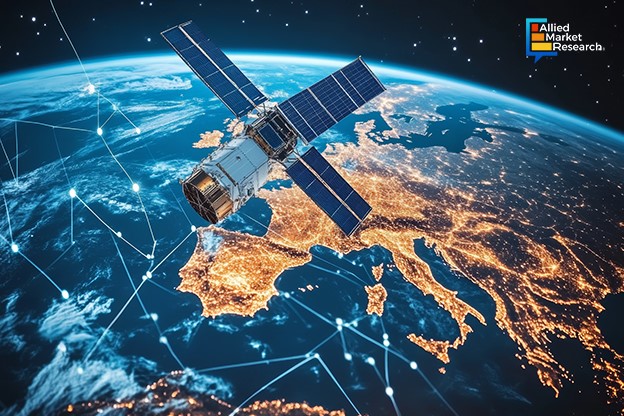Satellite Services: Advanced SATCOM Solutions Enhancing Agricultural Productivity

3 Mar
2025
Highlights:
- Introduction
- Impact of satellite services on the agriculture sector
- Mergers and acquisitions in the industry
The idea of artificial satellites first came up in 1945 when Arthur C. Clarke, an English inventor, published an article highlighting the possible advantages of deploying communication devices in space that could relay radio signals. In 1957, the then Union of Soviet Socialist Republics launched Sputnik 1, the world’s first-ever artificial satellite, thus marking the dawn of the Space Age. Since then, the role of these machines has increased significantly. Moreover, the entry of private companies has widened the scope of satellite services.
Today, satellite services are not just confined to communication, but also include scientific research, navigation, earth observation, etc. Additionally, with advancements in digital imaging techniques, satellites are being used for remote sensing applications. The growing pace of digitalization and the rising penetration of the Internet across the globe has also strengthened the position of the satellite services industry. Furthermore, the launch of 5G technology in developed and developing countries is anticipated to help the sector flourish in the coming period.
Increased role of satellite services in agriculture driving industry growth
In developing countries such as India, Brazil, China, and Indonesia, the lack of adequate knowledge about soil types and properties, cropping patterns, and weather forecasting has kept the productivity of the agriculture sector stagnant for many decades. For instance, in countries like India, despite employing 45% workforce in the country, the farming industry contributes to just 18% of the entire GDP. As per many experts, important data inputs provided by satellite services can help improve this situation in the near future.
The main aim of introducing digital technologies in the farming sector is to help cultivators make better crop management decisions and enhance their overall incomes in the long run. One major advantage of satellite services as compared to other modern technologies is that they are accessible and affordable not just to large farmers, but also to small and marginal farmers. In middle and low-income countries where the share of such cultivators is large, these satellite communications (SATCOM) innovations play an important role in taking a large section of the population out of poverty
Artificial satellites launched specifically for agricultural purposes capture images of fields using high-resolution cameras and sensors. The data collected is then analyzed by experts to understand the health of the crops that are being cultivated. The analysis aids in the early identification of issues such as pests, crop diseases, etc., which helps farmers take prompt corrective action, ultimately enhancing farm productivity. The integration of Artificial Intelligence and deep learning models has further improved the quality of satellite services. These emerging technologies help cultivators predict crop yield based on various input parameters such as soil health, rainfall, temperature, sunlight, etc. Through this study, farmers can make better planting and harvesting decisions. Furthermore, these insights help them mitigate the impact of natural disasters such as floods and droughts effectively.
M&A deals among major companies strengthening the industry’s position
In the last few years, the strategic alliances established by leading players in the industry are expected to help the satellite services industry gather a revenue of $241.1 billion by 2033. The market accounted for $110 billion in 2023, rising at a CAGR of 8.5% during 2024-2033. The M&A and partnership deals signed by leading businesses have created new investment opportunities in the sector. For instance, in January 2024, John Deere & Co., an agricultural equipment manufacturer, announced that it had signed a definitive agreement to collaborate with SpaceX, an astronautics company. As part of this deal, the companies are planning to provide advanced satellite communication services to rural areas and remote regions across the world to improve the quality of precision agriculture techniques used in these provinces. The partnership, thus, aims to empower cultivators by reducing their input costs of farming and increasing their profitability in the long run.
On the other hand, in September 2024, Network Innovations, a major telecommunications company, reported that it had acquired Infosat Communications, a satellite services provider. The press release issued by Network Innovations stated that the company aims to expand its portfolio, and the acquisition of Infosat Communications is expected to aid in improving LEO networks in the coming period.
Winding up, satellite services have become quite popular in contemporary times due to increasing applicability in different end-use industries. The agriculture sector has witnessed a huge transformation due to the introduction of advanced SATCOM solutions which aid in monitoring crop health and recording various parameters such as soil health and rainfall. The strategic alliances between multinational giants are anticipated to help the market flourish in the near future.
Contact our experts for insights on the growth drivers and investment opportunities in the sector!

Akhilesh Prabhugaonkar
Author's Bio- Akhilesh Prabhugaonkar holds a bachelor’s degree in Electronics Engineering from the reputed Vishwakarma Institute of Technology. He has a special interest in the fields of forensics, world history, international relations and foreign policy, sports, agriculture, astronomy, security, and oceanography. An ardent bibliophile and melophile, Akhilesh loves to write on topics of his interest and various other societal issues. This love for writing made him enter the professional world of content writing and pursue his career in this direction.
Avenue: Entire Library membership of Allied Market Research Reports at your disposal
- Avenue is an innovative subscription-based online report database.
- Avail an online access to the entire library of syndicated reports on more than 2,000 niche industries and company profiles on more than 12,000 firms across 11 domains.
- A cost-effective model tailored for entrepreneurs, investors, and students & researchers at universities.
- Request customizations, suggest new reports, and avail analyst support as per your requirements.
- Get an access to the library of reports at any time from any device and anywhere.
Related Post
-
How are Submarine Cables Transforming Global Connectivity with Enhanced User Experience?
-
Endoscopy Procedures: Transformations in Techniques and Applications
-
AI-Powered Video Analytics: How the Product Actually Works for enterprises
-
Painting Robots: Transforming Precision Coating and Creative Applications
-
Innovations in Pharmacovigilance Systems Advancing Patient Safety
-
Understanding Edge Security: Keeping Data Safe Near the Source
-
Exploring the Use and Advancements of 3D Laser Scanners in Professional Applications
-
Reinforcing Industrial Controls with Smarter Tools and Training








